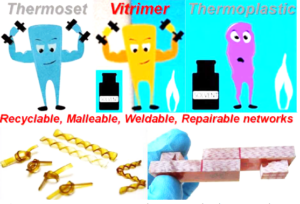Circular economy > MATVIT
Lancement
01/10/2018
Durée
42 months
Financeur(s)
ANR
Budget global
464 k €
MATVIT aims to develop a new generation of vitrimers with improved thermomechanical, viscoelastic and reprocessing properties. MATVIT is the first project on vitrimers financed by the ANR, with the Laboratory for Polymer Materials Engineering (IMP), the Soft Materials and Chemicals Laboratory (MMC) and IPC as partners.
Thermosets are polymer materials in which chemical bonds maintain a permanent 3D network linking all the polymer chains. Their thermomechanical resistance is far superior to that of thermoplastics. However, thermosets adopt a permanent form and cannot be reprocessed or recycled.
Vitrimers, pioneered by Leibler et al* in 2011 and highlighted by the 2015 European Inventor Award, overcome the disadvantages of thermosets by incorporating dynamic covalent cross-links into these networks, which are managed by exchange reactions in chemical equilibrium.
At high temperatures, chemical equilibrium is sufficiently rapid to promote the large-scale reorganisation of these networks, enabling the plastic to be deformed, reprocessed, recycled or welded. However, at low temperatures, chemical bond rearrangement is extremely slow and vitrimers behave like permanently interconnected networks with high durability and excellent solvent resistance. This unique behaviour among organic polymers makes vitrimers a new type of polymer at the boundary between thermoplastics and thermosets (Figure 1).
However, a major limitation of vitrimers is their inability to be processed at high flow rates using processes such as injection moulding or extrusion, due to insufficiently rapid exchange reactions and excessive viscosity at temperatures that prevent their degradation.

Figure 1. Vitrimers combine the best attributes and properties of thermosets and thermoplastics.
In this context, MATVIT suggests the development of several advanced materials that have the unique characteristics of vitrimers as well as original solutions that overcome their current limitations.
The objective is to develop a new generation of vitrimers with better thermomechanical and viscoelastic properties and better recyclability than those of current thermoset and thermoplastic materials.
To do this, the potential of vitrimer materials in key industrial applications must be demonstrated by using cutting-edge technologies.
Within the consortium, IPC’s role is to develop and characterise pre-stressed polymers and vulcanised vitrimer thermoplastics with very high melting points, as well as control of morphology.
* D. Montarnal, M. Capelot, F. Tournilhac, L. Leibler Science 2011, 334, 965.
The project’s ambitious, multidisciplinary research objectives go well beyond the current understanding of vitrimers. Two systems will be studied and developed:

IMP • Université de Lyon • ESPCI PARIS • IPC • MMC